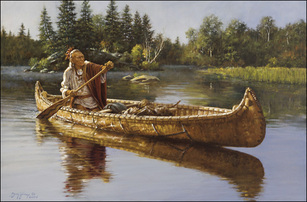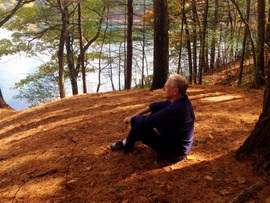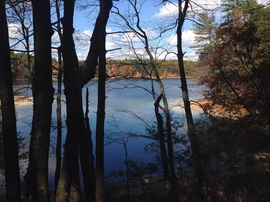Top Reasons to Preserve White Pond
 Squaw Sachem's Cove
Squaw Sachem's Cove
White Pond is an vital and valuable natural resource. Mother Nature is not making any more wild places. There are many reasons to preserve the pond and the land.
Environmental value

White Pond is the home of diverse and abundant wildlife including many species of fish, amphibians, birds, small and large mammals. The land is part of a network for contiguous open land for migrating animals which includes conservation land in Sudbury, the Sudbury River Valley and Great Meadows National Wildlife Refuge. The wetlands area include vernal pools inhabited by a variety of reptiles and amphibians including water snakes, wood frogs Spring peepers and painted turtles.
Mammals, including white-tailed deer, coyote, red fox, raccoon, fisher, mink, and beaver, chipmunk, rabbit, muskrat, skunk and groundhog live on this land.
Birds include: Carolina wren, phoebes, great blue heron, cardinal, thrush, indigo bunting, chickadee, wild turkey, bald eagle, swan, osprey, loons, sandpiper, merganser duck, Canada geese and crow.
Fish in the pond include: Crayfish, trout, bass and sunfish.
Click here for a slideshow of the wildlife of the pond and land.
Recreational Value

White Pond offer many recreational opportunities year round: swimming, boating, sailing, kayaking, fishing, ice fishing, jogging, walking, skating, cross country skiing, snow- shoeing, nature observation, photography and a chance for quiet contemplation. it is easily accessible for all ages and abilities via the state boat ramp where there is also handicapped parking.
Educational Value
 photo by Cherrie Corey
photo by Cherrie Corey
White Pond is an example of a northeast woodland ecosystem visited by individuals and school groups studying its geography and wildlife. There are fewer and fewer wild places for children to explore and feel safe while learning about the cycle of life and the seasons. White Pond provides a welcome laboratory to study and appreciate the web of life.
Historic Value

Native Americans from the Musketaquid tribe of the Nipmucs inhabited this area since at least 1000 B.C. Many arrowheads and stone tools have been found in area around White Pond. Indian campsites have been documented in the Plainfield-Anson Road area. Indian artifacts have also been found near Sachem's Cove.
The beautiful cove on the western edge of the pond, known as Squaw Sachem’s Cove is named after one of the original Native American signers of the 1635 deed granting land to Simon Willard and Peter Bulkeley who founded the town of Concord.
Squaw Sachem, was a female chief who lived in Mystic River area now occupied by the Towns of Arlington and Winchester. She was known as the queen of the Mystick and these lands were cared for by her tribe.
In The Ponds chapter of Walden, Thoreau celebrates the chain of wooded ponds of the “lake country”: Farrar Pond, Flint’s Pond, Goose Pond, Walden Pond, Fairhaven Bay and White Pond. For Thoreau, ponds are the most beautiful and expressive feature of the land. He called White Pond “ the most attractive if not the most beautiful of all our lakes, the gem of the woods”. Thoreau walked around the pond regularly sometimes with Ralph Waldo Emerson or Ellery Channing. Thoreau even used the sand from the pond to make sandpaper for his family’s pencil making business.
The beautiful cove on the western edge of the pond, known as Squaw Sachem’s Cove is named after one of the original Native American signers of the 1635 deed granting land to Simon Willard and Peter Bulkeley who founded the town of Concord.
Squaw Sachem, was a female chief who lived in Mystic River area now occupied by the Towns of Arlington and Winchester. She was known as the queen of the Mystick and these lands were cared for by her tribe.
In The Ponds chapter of Walden, Thoreau celebrates the chain of wooded ponds of the “lake country”: Farrar Pond, Flint’s Pond, Goose Pond, Walden Pond, Fairhaven Bay and White Pond. For Thoreau, ponds are the most beautiful and expressive feature of the land. He called White Pond “ the most attractive if not the most beautiful of all our lakes, the gem of the woods”. Thoreau walked around the pond regularly sometimes with Ralph Waldo Emerson or Ellery Channing. Thoreau even used the sand from the pond to make sandpaper for his family’s pencil making business.
Psychological Value

White Pond is the “commons” for several neighborhoods who visit the land regularly. As a wild area, this land gives the community a place to enjoy natural beauty. Spending time outside in nature is a proven way to improve mood, increase creativity, lower levels of stress, depression and anxiety.
Economic Value

The town's White Pond well is within 1,000 feet of the pond. Maintaining this area is vital to the health of our town water supply. Any degradation of the water could require town funds to remedy. The neighborhoods around the pond will retain their real estate value as long as the quality of the pond remains high.
Geographic Value

White Pond, a sister pond to Walden Pond, is an example of a kettle pond formed during the last ice age, 12,000 years ago. The pond itself has a maximum depth of 60 feet and is about 43 acres. It is a deep bowl with steep sandy banks supported by both deciduous and evergreen trees. White Pond has no inlets or outlets and is fed entirely by groundwater and runoff making the water vulnerable to degradation from misuse.